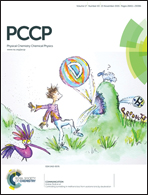A weight averaged approach for predicting amide vibrational bands of a sphingomyelin bilayer†
Abstract
Infrared (IR) and Raman spectra of a sphingomyelin (SM) bilayer have been calculated for the amide I, II and A modes and the double-bonded CC stretching mode by a weight averaged approach, based on an all-atom molecular dynamics (MD) simulation and a vibrational structure calculation. Representative structures and statistical weights of SM clusters connected by hydrogen bonds (HBs) are observed in MD trajectories. After constructing smaller fragments from the SM clusters, the vibrational spectra of the target modes were calculated by normal mode analysis with a correction for anharmonicity, using density functional theory. The final IR and Raman spectra of a SM bilayer were obtained as the weight averages over all SM clusters. The calculated Raman spectrum is in excellent agreement with a recent measurement, providing a clear assignment of the peak in question observed at 1643 cm−1 to the amide I modes of a SM bilayer. The analysis of the IR spectrum has also revealed that the amide bands are sensitive to the water content inside the membrane, since their band positions are strongly modulated by the HB between SM and water molecules. The present study suggests that the amide I band serves as a marker to identify the formation of SM clusters, and opens a new way to detect lipid rafts in the biological membrane.


 Please wait while we load your content...
Please wait while we load your content...